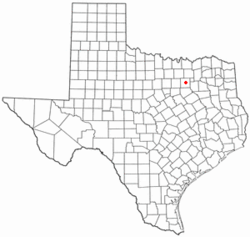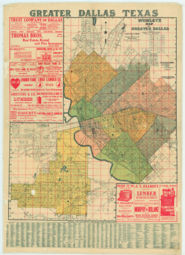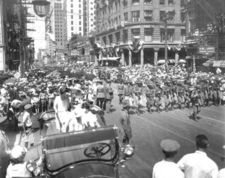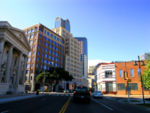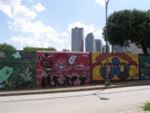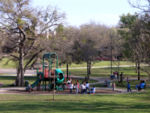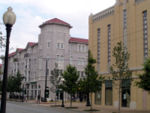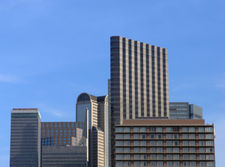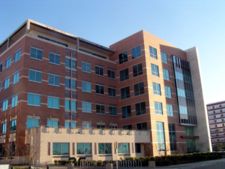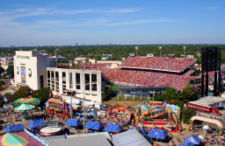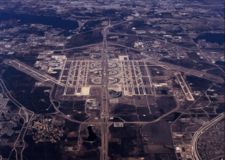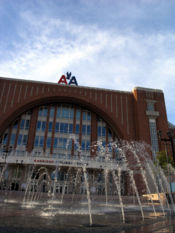Dallas, Texas
2007 Schools Wikipedia Selection. Related subjects: North American Geography
| Dallas, Texas | |||||
|
|||||
| Nickname: "Big 'D'" | |||||
| Location in the state of Texas | |||||
| Country | United States | ||||
|---|---|---|---|---|---|
| State | Texas | ||||
| Counties | Dallas, Collin, Denton, Kaufman, and Rockwall | ||||
| Mayor | Laura Miller | ||||
| Area | |||||
| - City | 997.1 km² (385.0 sq mi) | ||||
| - Land | 887.2 km² (342.5 sq mi) | ||||
| - Water | 110.0 km² (42.5 sq mi) | ||||
| Elevation | 33 m (108 ft) | ||||
| Population | |||||
| - City (2005) | 1,213,825 | ||||
| - Density | 1,364/km² (3,534/sq mi) | ||||
| - Urban | 4,638,000 | ||||
| - Metro | 5,819,475 | ||||
| Time zone | Central ( UTC-6) | ||||
| - Summer ( DST) | Central ( UTC-5) | ||||
| Website: http://www.dallascityhall.com | |||||
Dallas ( pronounced [ˈdæl.ʊs] or "DAL-us") is the third-largest city in the state of Texas and the ninth-largest in the United States. The city covers almost 400 square miles and is the county seat of Dallas County. As of 2005, U.S. Census estimates put Dallas at a population of 1,213,825. The city is the main cultural and economic centre of the 12-county Dallas–Fort Worth–Arlington metropolitan area—at over 5.8 million people, it is the fifth-largest metropolitan area in the United States. Dallas is one of 11 U.S. world-class cities, as ranked by the Globalization and World Cities Study Group & Network.
Dallas was founded in 1841 and formally incorporated as a city on 2 February 1856. The city is known globally as a centre for telecommunications, computer technology, banking, and transportation. It is the core of the largest inland metropolitan area in the United States and lacks any navigable link to the sea—Dallas' prominence despite this comes from its historical importance as a centre for the oil and cotton industries, its position along numerous railroad lines, and its powerful industrial and financial tycoons.
In a larger context, the area is seen as right-wing politically, with a heavy cultural emphasis placed on Protestant Christianity and close historical and cultural ties to both the rugged American West and agricultural South. The popular television series Dallas bolstered this view epitomizing the city with wealthy oil barons, big hair and cowboy hats. However, in the 2004 presidential election, 75.05% of Dallas voters voted for the Democratic candidate. In the 2006 elections for Dallas Country judges, 41 out of 42 seats went to Democrats. Dallas as an individual entity lies roughly at the centre of the political spectrum, and is locally much more diverse with significant Hispanic, Korean, German, African American, Muslim and Jewish populations.
History
Caddo Native Americans inhabited the Dallas area before it was claimed, along with the rest of Texas, as a part of the Spanish Province of New Spain in the 1500s. The area was very close to French territory, but the boundary of the Spanish-speaking territory was moved upward a bit in 1819 with the Adams-Onís Treaty. Present-day Dallas remained under Spanish rule until 1821, when Mexico declared independence from Spain. The land that would become Dallas became part of the state of Coahuila y Tejas in the new nation. The Republic of Texas broke off from Mexico in 1836 and remained an independent country for nearly 10 years. In 1839, four years into the nation's existence, John Neely Bryan surveyed the area around Dallas and two years later in 1841 he founded the city of Dallas on the site. Bryan, who shared Sam Houston's insight into the wisdom of Native American customs, realized that the Caddo trails in the region intersected at one of the few natural fords for hundreds of miles along the wide Trinity floodplain. In 1846 the Republic of Texas was annexed by the United States and Dallas County was established. It is speculated that both the county and the city were named after George Mifflin Dallas, who was the eleventh United States Vice President at the time. However, the origin of the city's name is debatable; Bryan stated only that it was named "after my friend Dallas."
Dallas was formally incorporated as a town in 1856. The city had a few slaves, mostly brought by settlers from Alabama and Georgia. Dallas was just another small town dotting the Texas frontier until after the American Civil War in which it was part of the Confederate States of America, and only legally became a city in 1871. The city paid the Houston and Central Texas Railroad US$5,000 to shift its route 20 miles (32 km) to the west and build its north-south tracks through Dallas, rather than through Corsicana as planned. A year later, Dallas leaders could not pay the Texas and Pacific Railroad to locate there, so they devised a way to trick the Railroad. Dallas had a rider attached to a state law which required the railroad to build its tracks through Browder Springs—which turned out to be just south of Main Street. In 1873, the major north-south and east-west Texas railroad routes intersected in Dallas, thus ensuring its future as a commercial centre.
By the turn of the twentieth century Dallas was the leading drug, book, jewelry, and wholesale liquor market in the Southwestern United States. It also quickly became the centre of trade in cotton, grain, and even buffalo. It was the world's leading inland cotton market, and it still led the world in manufacture of saddlery and cotton gin machinery. As it further entered the 20th century, Dallas transformed from an agricultural center to a centre of banking, insurance, and other businesses.
In 1930, oil was discovered 100 miles (160 km) east of Dallas and the city quickly became the financial centre for the oil industry in Texas and Oklahoma. In 1958 the integrated circuit was invented in Dallas by Jack Kilby of Texas Instruments; this event punctuated the Dallas area's development as a center for high-technology manufacturing. During the 1950s and 1960s, Dallas became the nation's third-largest technology centre, with the growth of such companies as Ling-Tempco-Vought ( LTV Corporation) and Texas Instruments. In 1957 two developers, Trammell Crow and John M. Stemmons, opened a Home Furnishings Mart that grew into the Dallas Market Centre, the largest wholesale trade complex in the world. On 22 November 1963, President John F. Kennedy was assassinated on Elm Street while his motorcade passed through Dealey Plaza in downtown Dallas.
In the 1970s and 1980s, Dallas underwent the building boom which produced a distinctive contemporary profile for the downtown area and a prominent skyline, influenced by nationally acclaimed architects. By the 1980s, when some oil industry companies relocated to Houston, Dallas was beginning to benefit from a burgeoning technology boom (driven by the growing Computer, Microchip, and Telecommunications industries), while continuing to be a centre of banking and business. Also in the mid-to-late 1980s, many banks, especially in Dallas, collapsed during the Savings and Loan crisis, nearly destroying the city's economy and scrapping plans for hundreds of structures. Because of the immense worldwide success of the hit television series Dallas, the city became one of the most internationally recognizable U.S cities during the 80s. In the 1990s, Dallas became known as the "Silicon Prairie", similar to California's Silicon Valley.
Like many major US cities, Dallas has experienced an "urban renewal" in the 2000s. From 1988 to 2005, not a single high-rise structure was built within the downtown freeway loop, and most new and upscale homes and subdivisions were being built in Richardson and Plano. In 2005, three towers began construction amid residential conversions and smaller residential projects. By the year 2010, the North Central Texas Council of Governments expects 10,000 residents to live within the loop. Just north, Uptown is one of the hottest real estate markets in the country.
Geography and environment
Dallas is the county seat of Dallas County. Portions of the city extend into neighboring Collin, Denton, Kaufman and Rockwall counties.
According to the United States Census Bureau, the city has a total area of 385.0 square miles (997.1 km²)—342.5 square miles (887.2 km²) of it is land and 42.5 square miles (110.0 km²) of it (11.03%) is water. These statistics are only for the city of Dallas proper. In fact, Dallas only makes up about one-fifth of the much larger urbanized area known as the Dallas-Fort Worth Metroplex. About a quarter of all Texans live in the DFW Metroplex.
Cityscape
The City of Dallas has many vibrant communities and eclectic neighborhoods. Major areas in the city include:
Central Dallas is anchored by Downtown, the centre of the city and the epicenter of urban revival, coupled with Oak Lawn and Uptown Dallas, the shiny new urban areas thriving with shops, restaurants, and nightlife. Downtown Dallas has a variety of neighborhoods, including the West End Historic District, the Arts District, the Main Street District, Farmers Market District, the City Centre business district, the Convention Centre District, the historic Vickery Place, the Reunion District and Victory Park. North of downtown is Oak Lawn, a densely-populated area that contains beautiful parks along Turtle Creek and the popular Uptown area with LoMac, Cityplace and the West Village.
The east side of Dallas contains the community of east Dallas, home to Deep Ellum, a trendy arts area close to downtown, homey Lakewood, Bryan Place, and historically and architecturally significant homes on Swiss Avenue. Above the Park Cities is north Dallas, home to mansions as palatial as Versailles in Preston Hollow, strong middle and upper-class communities north into Bent Tree and Far North Dallas, and high-powered shopping at Galleria Dallas, NorthPark Centre, and Preston Centre. East of north Dallas and north of east Dallas is Lake Highlands, one of the most unified middle-class areas in the city, with the strongest definition—it is in the northeastern part of the city above White Rock Lake and east Dallas.
The southern portion of Dallas is home to Oak Cliff, a hilly area in southwest Dallas that is predominately Hispanic and includes entertainment districts such as the Bishop Arts District. South Oak Cliff became a predominantly African American district after the early 1970's and has struggled with high rates of poverty and crime. To the east, south Dallas lays claim to the Cedars, an eclectic artist hotbed south of downtown, Fair Park, and areas west of the Trinity River and east of Interstate 35E. The University of North Texas at Dallas, currently located south of Oak Cliff along Interstate 20, is being built in the area along Houston School Road. Further east, above (north and east of) the Trinity River, is Pleasant Grove—once an independent city, it is a predominantly black collection of neighborhoods stretching to Seagoville to the southeast.
The city is further surrounded by many suburbs, with enclaves such as Cockrell Hill, Highland Park and University Park.
Geology

Dallas, and its surrounding area, is mostly flat and lies at an elevation ranging from 450 to 550 feet (137 to 168 m). The western edge of the Austin chalk formation, a limestone escarpment, rises 200 feet (61 m) and runs roughly north-south through Dallas County. The uplift is particularly noticeable in the neighbourhood of Oak Cliff and the adjacent cities of Cockrell Hill, Cedar Hill, Grand Prairie, and Irving. Marked variations in terrain are also found in cities immediately to the west in Tarrant County surrounding Fort Worth.
The Trinity River is a major Texas waterway that passes from the city of Irving into west Dallas, where it is paralleled by Interstate 35E along the Stemmons Corridor, then flows alongside western downtown, and through and alongside south Dallas and Pleasant Grove, paralleled by Interstate 45, where it exits into unincorporated Dallas County and heads southeast to Houston. The river is flanked on both sides with 50 feet (15 m) earthen levees to keep the city from flooding. Several bridges cross over the river connecting southern Dallas to downtown Dallas. From the early 2000s to the 2010s, the Trinity River Project, a major public works project undertaken by the city of Dallas, will improve the river along its length.
White Rock Lake is Dallas's other significant water feature. The lake and surrounding park is a popular destination among boaters, joggers, bikers, and skaters in the Lakewood/ Casa Linda Estates neighborhoods of East Dallas. The lake also boasts the 66 acre (267,000 m²) Dallas Arboretum and Botanical Garden on its shore. Bachman Lake, just northwest of Love Field, is a smaller lake and surrounding park that is also used for recreation. Lake Ray Hubbard, a 22,745 acre (9,205,000 m²) lake, is a vast and popular recreational lake located in an extension of Dallas surrounded by Garland, Rowlett, Rockwall and Sunnyvale. Mountain Creek Lake is a small lake along Dallas's border with Grand Prairie and is home to the (defunct as of September 1998) Naval Air Station Dallas ( Hensley Field). North Lake, a small lake in an extension of Dallas surrounded by Irving and Coppell, served primarily as a water source for a nearby power plant, but the surrounding area is now being targeted for redevelopment due to its proximity to Dallas-Fort Worth International Airport (a plan that the neighboring cities oppose).
Climate
Dallas receives approximately 37.1 inches (941.1 mm) of rain per year, much of which is delivered in the spring.
Dallas has a humid subtropical climate, yet this part of Texas also tends to receive hot, dry winds from the north and west in the summer. In the winter, strong cold fronts from the north pass through Dallas, plummeting temperatures well below freezing. The average annual snowfall in Dallas is 2.5 inches (6.35 cm), with snowfall seen six days out of the year and snow accumulation seen two days out of the year. Occasionally, warm and humid air from the south overrides cold, dry air, leading to freezing rain, which usually causes major disruptions in the city for a day or two if the roads and highways become dangerously slick. Regardless, winters are relatively mild compared with the Texas Panhandle and with other states to the north. Dallas winters are occasionally interspersed with Indian summers.
Spring and fall, and the moderate, pleasant temperatures accompanying these seasons, can sometimes be shorter-lived than residents would like. However, short the seasons are, residents and visitors appreciate the beauty of the vibrant wildflowers (such as the bluebonnet, Indian paintbrush and other flora) which bloom in spring and are planted around the highways throughout Texas. In the spring the weather can also be quite volatile and change quickly in a matter of minutes. The cliché about volatile climates popular in various parts of the US—"if you don't like the weather, wait a little while and it'll change"—applies well to Dallas's spring weather. The sporadic volatility of the spring season is coupled with a very pleasant "normality"—barring storms, Dallas in spring is very mild and enjoyable. Similarly, late September, October, and early November is very pleasant and is typically storm-free.
Although uncommon, with the last touch-down in 1957, tornadoes are perhaps the biggest threat to the city of Dallas. In the spring, cool fronts moving from Canada collide with warm, humid air streaming in from the Gulf Coast. When these fronts meet over Dallas, severe thunder storms are generated with spectacular lightning shows, occasional torrents of rain, hail, and, at times, tornadoes. They are common to the north, in Oklahoma, in the spring and summer, but the city itself is prone to the storms as it lies at the southern end of Tornado Alley, which runs through the prairie lands of the Midwest. Dallas was last hit by a tornado on 2 April 1957 that likely would have registered as an F3, but it missed downtown. In May 2000, the " Fort Worth Tornado" hit neighboring Fort Worth's downtown, causing damage to a pair of the city's skyscrapers.
The Metroplex experiences a particularly acute springtime "monsoon" season every year—around the middle of March—that rapidly feeds a unique region-wide runoff that swells Johnson Creek (in Arlington and Grand Prairie), as well as the West and Elm Forks of the Trinity River, onto several square miles of flood plain inside the metro area, much of it inhabited. Every March, many neighborhoods in these cities have 4 or more feet of water inside dwellings, and low-lying developed areas adjacent to the Stemmons Corridor and Oak Cliff in Dallas experience severe flooding.
The U.S. Department of Agriculture places the city of Dallas in Plant Hardiness Zone 8a. Dallas has the 12th worst ozone air pollution in the nation according to the American Lung Association, ranking it ahead of Los Angeles and Fresno, California, and Houston. Much of the air pollution in Dallas, and the DFW Metroplex in general, comes from a hazardous materials incineration plant in the southern-most suburb of Midlothian, as well as concrete installations in neighboring Ellis County.
The average daily low in Dallas is 57 °F (14 °C) and the average daily high in Dallas is 77 °F (25 °C).
| Month | Jan | Feb | Mar | Apr | May | Jun | Jul | Aug | Sep | Oct | Nov | Dec | Year |
|---|---|---|---|---|---|---|---|---|---|---|---|---|---|
| Avg high ° F (° C) | 55 (13) | 61 (16) | 69 (21) | 77 (25) | 84 (29) | 92 (33) | 96 (36) | 96 (36) | 89 (32) | 79 (26) | 66 (19) | 57 (14) | 77 (25) |
| Avg low °F (°C) | 36 (2) | 41 (5) | 49 (9) | 56 (13) | 65 (18) | 73 (23) | 77 (25) | 76 (24) | 69 (21) | 58 (14) | 47 (18) | 39 (4) | 57 (14) |
| Rainfall in ( mm) | 1.89 (48) | 2.31 (59) | 3.13 (80) | 3.46 (88) | 5.30 (135) | 3.92 (100) | 2.43 (62) | 2.17 (55) | 2.65 (67) | 4.65 (118) | 2.61 (66) | 2.53 (64) | 37.1 (942) |
Demographics
| Year | Pop. |
|---|---|
| 1860 | 678 |
| 1870 | 3,000 |
| 1880 | 10,358 |
| 1890 | 38,067 |
| 1900 | 42,638 |
| 1910 | 92,104 |
| 1920 | 158,976 |
| 1930 | 260,475 |
| 1940 | 294,734 |
| 1950 | 434,462 |
| 1960 | 679,684 |
| 1970 | 844,401 |
| 1980 | 904,078 |
| 1990 | 1,006,877 |
| 2000 | 1,188,580 |
| 2005 ( est.) | 1,213,825 |
As of the census GR2 of 2000, there were 1,188,580 people, 451,833 households, and 266,581 families residing in the city proper, which is bounded by largely developed suburbs and exurbs. The population density was 3,469.9 people per square mile (1,339.7/km²). There were 484,117 housing units at an average density of 1,413.3 per square mile (545.7/km²). The racial makeup of the city was 50.83% White, 25.91% Black or African American, 0.54% Native American, 2.70% Asian, 0.05% Pacific Islander, 17.24% from other races, and 2.72% from two or more races. 35.55% of the population was Hispanic or Latino of any race. Hispanics outnumbered African-Americans for the first time in the 2000 census as the largest minority group in Dallas. Many newly-arrived Hispanics have settled in poorer neighborhoods such as Oak Cliff that were once predominately African American. While Hispanics have moved in, many African Americans have migrated further south to cities such as Cedar Hill, Lancaster and DeSoto that until recently were predominately White communities.
There were 451,833 households out of which 30.3% had children under the age of 18 living with them, 38.8% were married couples living together, 14.9% had a female householder with no husband present, and 41.0% are classified as non-families by the United States Census Bureau. Of 451,833 households, 23,959 are unmarried partner households: 18,684 heterosexual, 3,615 same-sex male, and 1,660 same-sex female households. 32.9% of all households were made up of individuals and 6.5% had someone living alone who was 65 years of age or older. The average household size was 2.58 and the average family size was 3.37.
In the city the population was spread out with 26.6% under the age of 18, 11.8% from 18 to 24, 35.3% from 25 to 44, 17.7% from 45 to 64, and 8.6% who were 65 years of age or older. The median age was 30 years. For every 100 females there were 101.6 males. For every 100 females age 18 and over, there were 100.5 males.
The median income for a household in the city was $37,628, and the median income for a family was $40,921. Males had a median income of $31,149 versus $28,235 for females. The per capita income for the city was $22,183. About 14.9% of families and 17.8% of the population were below the poverty line, including 25.1% of those under age 18 and 13.1% of those aged 65 or over. In 2006 the median price for a house was $123,800, and save a 2003 recession, Dallas has seen a steady increase in the cost of homes over the past 6 years.
Economy
In its beginnings, Dallas relied on farming, neighboring Fort Worth's cattle market, and its prime location on trade routes with Indians to sustain itself. Dallas' real key to growth came in 1873 though with the building of multiple rail lines through the city. As Dallas grew and technology developed, cotton became its boon—By 1900 Dallas was the largest inland cotton market on Earth and led the world in cotton gin machinery manufacturing. By the early 1900s, Dallas was a hub for economic activity all over the Southwestern United States; by 1925, Texas churned out more than ⅓ of the nation's cotton crop, and 31% of Texas cotton was produced within a 100 mile (161 km) radius of Dallas. In the 1930s, oil was discovered east of Dallas near Kilgore, Texas and Dallas' proximity to the discovery put it at the centre of the nation's oil market. Oil discoveries in the Permian Basin, the Panhandle, the Gulf Coast and Oklahoma in the following years further solidified Dallas' position as the hub of the market as it was roughly the geographic centre of all 5 regions.
After World War II, Dallas was seeded with a nexus of communications engineering and production talent by companies such as Collins Radio Corp. The telecommunication and information revolutions that ensued still drive a great deal of the local economy. The city is sometimes referred to as Texas's Silicon Valley or the "Silicon Prairie" because of a high concentration of telecommunications companies—the epicenter of which lies along the " Telecom Corridor", home to more than 5,700 companies. The corridor is also home to Texas Instruments and regional offices for Alcatel, AT&T, Ericsson, Fujitsu, MCI, Nokia, Nortel, Rockwell, Sprint and Verizon.
In the 1980s, Dallas was a real-estate hot-bed, with populations skyrocketing and the demand for housing and jobs soaring along with it. Downtown Dallas's largest buildings are all the fruit of this boom, but over-speculation and the Savings and Loan crisis knocked the area to its knees. Between the crash and the early 2000s, Dallas suffered a lengthy recession and has only recently bounced back—like much of the country, the real estate market is once again very hot in Dallas, and with relatively low costs of living, a real estate bubble is unexpected.
Dallas is no longer a hotbed for manufacturing like it was in the early 20th century—partially due to constraints placed by the DFW Ozone Nonattainment Area—but plenty of goods are still manufactured in the city. Texas Instruments employs 10,400 people at its corporate headquarters and chip plants in Dallas and neighborhing Richardson. Oak Farms Dairy also headquarters and has a plant in the city.
Companies headquartered in Dallas include ExxonMobil, the largest company in the world (by revenue), 7-Eleven, Blockbuster, DR Horton Homes, EDS, ENSCO Offshore Drilling, Kimberly-Clark, Mary Kay Cosmetics, Southwest Airlines, Texas Instruments, and Zales. Corporate headquarters in the northern suburb of Plano include Frito Lay, Dr Pepper and JCPenney.
The Dallas metroplex has more shopping centers per capita than any other United States city and metro, and the city itself is home to 11 billionaires—concentrated in the Preston Hollow area of north Dallas—placing it 9th worldwide among cities with the most billionaires.
Law and government
The current mayor of Dallas is Laura Miller. The city is split into 14 different council districts with council members appointed to the city council for each district. The city operates as a mayor-council government. This organizational structure was recently contested by some in favour of a strong-mayor city charter only to be rejected by Dallas voters.
In the 2006-2007 fiscal year, the city's total budget (the sum of operating and capital budgets) was US$2,344,314,114. The city has seen a steady increase in its budget throughout its history due to sustained growth: the budget was $1,717,449,783 in 2002-2003, $1,912,845,956 in 2003-2004, $2,049,685,734 in 2004-2005 and $2,218,345,070 in 2005-2006.
| F E D E R A L |
House of Representatives | Senate | ||||
| Name | Party | District | Name | Party | ||
| Sam Johnson | Republican | District 3 | Kay Bailey Hutchison | Republican | ||
| Ralph Hall | Republican | District 4 | John Cornyn | Republican | ||
| Jeb Hensarling | Republican | District 5 | ||||
| Kenny Marchant | Republican | District 24 | ||||
| Eddie Bernice Johnson | Democrat | District 30 | ||||
| Pete Sessions | Republican | District 32 | ||||
| S T A T E |
Texas Legislature | |||||
| Name | Party | District | Name | Party | District | |
| Bob Deuell | Republican | District 2 | John Carona | Republican | District 16 | |
| Florence Shapiro | Republican | District 8 | Royce West | Democrat | District 23 | |
| Chris Harris | Republican | District 9 | Craig Estes | Republican | District 30 | |
Protection
Recently in 2006 Dallas was named Texas' Most Dangerous City.
Policing in Dallas is provided by the Dallas Police Department which has 2,977 officers. The Dallas chief of police is David Kunkle. The central police station is located in the Cedars, a south Dallas neighbourhood near downtown.
From 1998 until 2005 (the most recent year with available statistics), the city of Dallas has had the highest overall crime rate for the nine United States cities with over 1 million people. Violent crime in Dallas was also ranked #1 during the same time period. Murders peaked at 500 in 1991. It then fluctuated from 227 in 2000 to 240 in 2001, 196 in 2002, 223 in 2003, 275 in 2004, and finally 198 in 2005, marking a sharp decline over the two previous years. However, Dallas was again ranked in 2005 as the most dangerous city out of the ten largest cities in the United States.
Fire protection in the city is provided by Dallas Fire-Rescue, which has 1,670 firefighters and 55 working fire stations in the city limits. The Dallas Fire & Rescue chief is Eddie Burns, Sr. The department also operates the Dallas Firefighter's Museum at Dallas's oldest remaining fire station, built in 1907, along Parry Avenue near Fair Park.
Culture
The city has historically been predominately white but its population diversified over the 20th century. It is a major destination for Mexican immigrants seeking opportunity in the United States while staying close to their home in Mexico. Generally, the southwest area of the city is Hispanic, the southern and southeastern areas of the city are black, the north and eastern parts of the city are white and the northwestern portion of the city is Hispanic and Asian.
Dallas is renowned for barbeque, authentic Mexican and Tex-Mex cuisine. Famous products of the Dallas culinary scene include El Fenix, Mi Cocina, Bone Daddy's Barbeque, the Mansion on Turtle Creek, and the frozen margarita. On average, Dallasites eat out about four times every week, which is the third highest rate in the country, behind Houston and Austin, and Dallas has more restaurants per capita than New York City.
Arts
The Arts District in downtown is home to several arts venues, both existing and proposed. Notable venues in the district include the Dallas Museum of Art, the Morton H. Meyerson Symphony Centre, The Trammell & Margaret Crow Collection of Asian Art, the Nasher Sculpture Centre, and nearby The Dallas Contemporary. Venues under construction or planned include the Winspear Opera House and the Dallas Centre for the Performing Arts. The district is also home to DISD's Booker T. Washington High School for the Performing and Visual Arts, which is currently being expanded.
Deep Ellum originally became popular during the 1920s and 1930s as the prime jazz and blues hotspot in the south. Artists such as Blind Lemon Jefferson, Robert Johnson, Huddie " Leadbelly" Ledbetter, and Bessie Smith played in original Deep Ellum clubs such as The Harlem and The Palace. Today, Deep Ellum is home to hundreds of artists who live in lofts and operate in studios throughout the district alongside bars, pubs, and concert venues. One major art infusion in the area is the city's lax stance on graffiti; consequently, several public ways including tunnels, sides of buildings, sidewalks, and streets are covered in murals. One major example, the Good-Latimer tunnel, was torn down in late 2006 to accommodate the construction of a light rail line through the site.
The Cedars has a growing population of studio artists and an expanding roster of entertainment venues. The area's art scene began to grow in the early 2000s with the opening of Southside on Lamar, a Sears warehouse converted into lofts, studios, and retail. Current attractions include Gilley's Dallas and Poor David's Pub. Entrepreneur Mark Cuban purchased land along Lamar Avenue near Cedars Station in September 2005 and locals speculate that he is planning an entertainment complex for the site.
The Bishop Arts District in Oak Cliff is home to a number of studio artists living in converted warehouses. Walls of buildings along alleyways and streets are painted with murals and the surrounding streets contain many eclectic restaurants and shops.
Dallas has an Office of Cultural Affairs as a department of the city government. The City of Dallas Office of Cultural Affairs is responsible for six cultural centers located throughout the city, funding for local artists and theatres, public art projects and running the city owned radio station WRR.
Religion
There is a large Protestant influence on the Dallas community and the city is deep within the Bible Belt— Methodist and Baptist churches are prominent in many neighborhoods and anchor the city's two major private universities. The Catholic Cathedral Santuario de Guadalupe in the Arts District oversees the second largest membership in the country. There is a vibrant Mormon community, which led The Church of Jesus Christ of Latter-day Saints to build the Dallas Texas Temple in 1984. There is a large Jewish community in the Dallas area, especially notable in northern Dallas. Dallas has a significant Muslim community and is also home to the Cathedral of Hope, the largest GLBT congregation in the world. Dallas is also home to three Eastern Orthodox Christian churches. The First Unitarian Church of Dallas describes itself as "liberal religious presence in Dallas since 1899."
Events
Dallas is home to several significant events throughout the year. Perhaps the most notable is the annual State Fair of Texas held annually at Fair Park since 1886. The fair is a massive event for the state's 22 million people and brings an estimated US$350 million to the city's economy annually. The Red River Shootout (UT- OU) game at the Cotton Bowl and other Cotton Bowl games also bring significant crowds to the city. Other festivals in the area include Cinco de Mayo festivities, extravagant Independence Day events, Saint Patrick's Day parades in Irish communities such as Lower Greenville, Juneteenth festivities, and the annual Halloween parade on Oak Lawn.
Architecture
Most of the notable architecture in Dallas is modernist and postmodernist. Iconic examples of modernist architecture include I. M. Pei's Fountain Place, the Bank of America Plaza, Renaissance Tower, and Reunion Tower. Examples of postmodernist architecture include the JPMorgan Chase Tower and Bank One Centre. Several smaller structures are fashioned in the Gothic Revival ( Kirby Building) and neoclassical ( Davis and Wilson Buildings) styles. One architectural "hotbed" in the city is a stretch of homes along Swiss Avenue, which contains all shades and variants of architecture from Victorian to neoclassical.
Tallest structures in Dallas
| By structural height | By roof height |
|
|
Education
Colleges and universities
Dallas is a major centre of education for much of the South Central United States. The city itself contains several universities, colleges, trade schools, and educational institutes. Several major Universities also lie in enclaves, satellite cities, and suburbs of the city.
Southern Methodist University (SMU) is a private, coeducational university in University Park, an enclave of Dallas. It was founded in 1911 by the Southern Methodist Church and now enrolls 6,500 undergraduates, 1,200 professional students in the law and theology departments, and 3,500 postgraduates.
The University of Texas Southwestern Medical School is a prestigious medical school located in the Stemmons Corridor of Dallas. It is part of the University of Texas Southwestern Medical Centre at Dallas, again one of the largest facilities of its kind in the world. The school is highly selective, admitting around 200 students a year. The facility enrolls 3,255 postgraduates and is home to four Nobel Laureates: three in physiology/medicine and one in chemistry.
Dallas Baptist University (DBU) is a private, coeducational university located in the Mountain Creek area of southwestern Dallas. Originally in Decatur, it moved to Dallas in 1965. The school currently enrolls over 5,100 students.
Paul Quinn College is a private, historically Black college located in southeast Dallas. Originally in Waco Texas, it moved to Dallas in 1993 and is housed on the campus of the former Bishop College, another private, historically Black college. Dallas billionaire and entrepreneur Comer Cottrell, Jr., founder of ProLine Corporation, bought the campus of Bishop College and bequeathed it to Paul Quinn College in 1993. The school enrolls 3,000 undergraduate students.
The University of North Texas at Dallas, currently located at a temporary site south of Oak Cliff along Interstate 20, is being built in south Dallas along Houston School Road. The school will be the first public university within Dallas city limits.
Also in the nearby suburbs and neighboring cities are the University of Texas at Dallas in Richardson, the University of Dallas in Irving, the University of North Texas in Denton, and the University of Texas at Arlington in Arlington.
Schools
The city of Dallas is mostly within the Dallas Independent School District, the twelfth-largest school district in the United States. The school district operates independently of the city and enrolls over 161,000 students. In 2006, one of the district's magnet schools, The School for the Talented and Gifted, was named the best school in the United States (among public schools) by Newsweek. Another one of DISD's schools, the Science and Engineering Magnet, came in at number eight in the same survey. Other DISD schools named to the list were * Woodrow Wilson High School, Hillcrest and W.T. White Highs. "Woodrow" as it is colloquially known, was also named the top comprehensive high school in Dallas by local publication D Magazine. The Wildcats regularly produce as many or more National Merit Scholars as local private and suburban schools.
Dallas also extends into several other school districts including Carrollton-Farmers Branch, Duncanville, Garland, Highland Park, Mesquite, Plano, and Richardson. The Wilmer-Hutchins Independent School District once served portions of southern Dallas, but it was shut down for the 2005-2006 year. WHISD students started attending other Dallas ISD schools during that time. Following the close, the Texas Education Agency consolidated WHISD into Dallas ISD.
Many school districts in Dallas County, including Dallas ISD, are served by a governmental agency called Dallas County Schools. The system provides busing and other transportation services, access to a massive media library, technology services, strong ties to local organizations for education/community integration, and staff development programs.
There are also several highly prestigious private schools in Dallas, most notably St. Mark's School of Texas, The Hockaday School, Episcopal School of Dallas, Jesuit College Preparatory School of Dallas, Bishop Dunne Catholic School, Bishop Lynch High School, and Ursuline Academy of Dallas. Cistercian Preparatory School, attended by many Dallas residents, is in nearby Irving and Greenhill School is in adjacent Addison. Time magazine once called St. Mark's School of Texas the "best-equipped day school in the country."
Libraries
The city is served by the Dallas Public Library system. The system was originally created by the Dallas Federation of Women's Clubs with efforts spearheaded by then-president Mrs. Henry (May Dickson) Exall. Her work raising money led to a grant from philanthropist and steel baron Andrew Carnegie, which enabled the construction of the first branch in 1901. Today the library operates 22 branch locations throughout the city including the J. Erik Jonsson Central Library, the 8-story main branch in the Government District of downtown.
Infrastructure
Health and medicine
The city of Dallas has many hospitals within its bounds and a number of medical research facilities. One major research centre is UT Southwestern Medical Centre in the Stemmons Corridor, along with its affiliate medical school, UT Southwestern Medical School. The system includes Parkland Memorial Hospital and Children's Medical Centre Dallas.
The city also has a VA hospital in south Dallas, the Dallas Veterans Affairs Medical Centre. Dallas is the home of a Consolidated Mail Outpatient Pharmacy (CMOP). It is part of an initiative by the Department of Veterans Affairs to provide mail order prescriptions to veterans using computerization at strategic loactions throughout the United States.
Other hospitals include Baylor University Medical Centre in east Dallas, Central Methodist Hospital in Oak Cliff, Charlton Methodist Hospital near Duncanville, Medical City Dallas Hospital and Presbyterian Hospital in north Dallas, and the Texas Scottish Rite Hospital for Children in Oak Lawn.
Transportation
The primary mode of local transportation in the city is the automobile. Efforts to diversify including the construction of light rail lines, biking and walking paths, wider sidewalks, and more efficient public transportation are currently major priorities of the city and its residents. The city is much like other United States cities developed primarily in the late 20th century—criss-crossed by a vast network of highways which has led to and contributes to Dallas being a very low-density city.
The city of Dallas is at the confluence of a large number of major interstate highways—Interstates 20, 30, 35E, and 45 all run through the city. The city's freeway system, as it has no major geographical inhibitors surrounding it, is set up in the popular hub-and-spoke system, much like a wagon wheel. Starting from downtown Dallas, there is the main downtown freeway loop, the Interstate 635/ 20 Lyndon B. Johnson loop, and ultimately the tolled President George Bush Turnpike. Inside these freeway loops are other partially-limited-access and parkway-style loops including Loop 12 and Belt Line Road. Another beltway around the city is planned upwards of 46.50 miles (70 km) from downtown in Collin County. Radiating out of downtown as the spokes of the system are Interstates 30, 35E, and 45, US 75, US 175, TX Spur 366, the tolled Dallas North Tollway, and further out TX 114, US 80 and US 67. Other major highways within the city that do not serve primarily as spokes include TX 183 and TX Spur 408. The recently completed interchange for Interstate 635 and Central Expressway, called the High Five Interchange, contains five stacks and is one of the largest freeway interchanges in the United States.
Dallas Area Rapid Transit (DART) is the Dallas area public transportation authority, providing buses, rail, and HOV lanes. DART began operating the first light rail system in the Southwest United States in 1996 and continues to expand its coverage. Currently, two light rail lines are in service. The red line travels through Oak Cliff, South Dallas, downtown, Uptown, north Dallas, Richardson and Plano. The blue line goes through south Dallas, downtown, Uptown, east Dallas, Lake Highlands, and Garland. The red and blue lines are conjoined in between 8th & Corinth Station in Oak Cliff and Mockingbird Station in north Dallas. The two lines service Cityplace Station, the only subway station in the Southwest.
Fort Worth's smaller public transit system, The T, connects with Dallas's via a commuter rail line, the Trinity Railway Express, connecting downtown Dallas's Union Station with downtown Fort Worth's T&P Station and several points in between. The system of light rail transit, especially through downtown, has skyrocketed land values and has sparked a residential boom in downtown.
Dallas is served by two commercial airports: Dallas/Fort Worth International Airport (known as DFW International) and Dallas Love Field. In addition, Dallas Executive Airport (formerly Redbird Airport), is a general aviation airport located within the city limits, and Addison Airport is another general aviation airport located just outside the city limits in the suburb of Addison. Two more general aviation airports are located in the outer suburb of McKinney, and two more general aviation airports are in Fort Worth, on the west side of the Metroplex.
DFW International Airport is located in the suburbs north of and equidistant to downtown Fort Worth and downtown Dallas. In terms of size, DFW is the largest airport in the state, the second largest in the United States, and third largest in the world. In terms of traffic, DFW is the busiest in the state, third busiest in the United States, and sixth busiest in the world. Love Field is located within the city limits of Dallas, 6 miles (10 km) northwest of downtown, and is headquarters to Southwest Airlines.
Utilities
Dallas is served by Dallas Water Utilities, which operates several waste treatment plants and pulls water from several area reservoirs. The city's electric system is maintained by TXU Electric Delivery, whose parent company, TXU, headquarters in the city. The city offers garbage pickup and recycling service weekly through its Sanitation Services department. Telephone networks are available from several companies and broadband Internet and cable television service is available for the majority of the city.
Sports
Dallas is home to the Dallas Desperados ( Arena Football League), Dallas Mavericks ( National Basketball Association), and Dallas Stars (National Hockey League). All three teams play at the American Airlines Centre. The Major League Soccer team FC Dallas, formerly the Dallas Burn, used to play in the Cotton Bowl but moved to Pizza Hut Park in Frisco upon the stadium's opening in 2005. The college football game, aptly named the Cotton Bowl is still played there, however. The Dallas Sidekicks, a former team of the Major Indoor Soccer League, used to play in Reunion Arena. The Texas Tornado, three-time defending champions of the North American Hockey League, plays at the Deja Blue Arena in Frisco.
Nearby Irving is home to the 5-time Super Bowl Champions, Dallas Cowboys of the National Football League while Arlington is home to the Texas Rangers of Major League Baseball.
Other teams in the Dallas area include the Dallas Harlequins of the USA Rugby Super League, and the Frisco RoughRiders of Minor League Baseball in Frisco. The Dallas Diamonds, the two-time national champions of the Women's Professional Football League Women's American football team, plays in North Richland Hills. McKinney is home to the Dallas Revolution, an Independent Women's Football League Women's American football team.
Recreation
The City of Dallas maintains and operates 406 parks on 21,000 acres (8,500,000 m²) of parkland. Its flagship park is the 260 acre (1,000,000 m²) Fair Park which was originally developed to host the Texas Centennial Exposition in 1936. The city is also home to Texas' first and largest zoo at 95 acres (405,000 m²) — the Dallas Zoo, which first opened in 1888.
The city's parks contain 17 separate lakes, including White Rock and Bachman lakes, spanning a total of 4,400 acres (1,780,000 m²). The city is criss-crossed with 61.6 miles (99 km) of bike & jogging trails, including the Katy Trail, and is home to 47 community and neighborhood recreation centers, 276 sports fields, 60 swimming pools, 232 playgrounds, 173 basketball courts, 112 volleyball courts, 126 play slabs, 258 neighbourhood tennis courts, 258 picnic areas, six 18-hole golf courses, two driving ranges, and 477 athletic fields.
To the west of Dallas in Arlington is Six Flags Over Texas, one of the biggest theme parks in the United States. Hurricane Harbour, a large water park, is also in Arlington.



